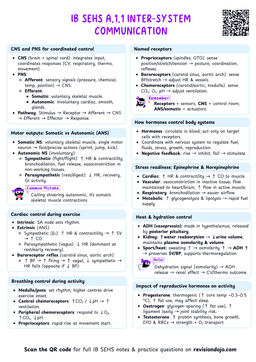The Nervous System and Its Role in Coordinating Physiological Responses
- The nervous system is a specialized network of cells (neurons) that communicate electrical signals throughout the body.
- It enables the body to sense and respond to internal and external stimuli, maintaining homeostasis through coordinated regulation of physiological processes.
Homeostasis
Homeostasis is the maintenance of a stable internal environment within an organism, ensuring optimal conditions for cellular processes.
Basics of Nervous System
Key Functions of the Nervous System
- Sensory Input: Detects changes in the internal and external environments.
- Integration: Processes and interprets sensory input.
- Motor Output: Initiates responses to changes, such as muscle contraction or gland secretion.
Divisions of the Nervous System
The nervous system is divided into two main parts:
- Central Nervous System (CNS)
- Components: Brain and spinal cord.
- Function: Serves as the control center of the body, processes information, and sends instructions to the body.
- Peripheral Nervous System (PNS)
- Components: Nerves extending from the spinal cord to the rest of the body (limbs, organs, etc.).
- Function: Connects the CNS to the limbs and organs, transmitting sensory information to the CNS and motor commands from the CNS to muscles and glands.

Think of the CNS as the brain of a computer and the PNS as the wires connecting it to the rest of the system (like keyboard, screen, etc.).
Central Nervous System
The CNS consists of the brain and spinal cord and is responsible for processing information, making decisions, and directing responses.
Brain
- The brain is the body's "central computer," integrating sensory input and generating responses.
- It is involved in everything from conscious thought to unconscious functions like breathing.
Key Areas of the Brain
- Cerebrum: The largest part of the brain, responsible for higher brain functions such as thought, memory, and voluntary movement.
- Cerebellum: Coordinates voluntary movements and balance.
- Brainstem: Controls vital functions like heart rate and breathing.

Spinal Cord
- The spinal cord relays messages between the brain and the rest of the body.
- It is essential for both sensory input and motor output.
Efferent Division of the Nervous System
- The efferent division is responsible for carrying motor commands from the CNS to various body parts, resulting in movement or other physiological responses.
- This division is further subdivided into the autonomic nervous system and the somatic nervous system.
The Autonomic Nervous System (ANS)
The ANS regulates involuntary body functions and is divided into two branches: the sympathetic and parasympathetic nervous systems.
Sympathetic nervous system
The part of the autonomic nervous system that triggers the body's "fight or flight" responses.
Parasympathetic nervous system
The part of the autonomic nervous system that triggers the "rest and digest" functions.

| Branch | Function | Example of Action |
|---|---|---|
| Sympathetic | Activates "fight or flight" response. Increases heart rate, dilates pupils, increases respiration. | Heart Rate Increase during stress or physical activity. |
| Parasympathetic | Promotes "rest and digest." Slows heart rate, stimulates digestion. | Heart Rate Decrease after exercise or during relaxation. |
The sympathetic system is activated during stressful situations, such as exercise or emotional stress, while the parasympathetic system is activated when the body is at rest and relaxed.
Tip- Sympathetic Nervous System: Think of S for Stress or Speed. It speeds up the body’s functions, preparing it for action.
- Parasympathetic Nervous System: Think of P for Peace or Pause. It slows down bodily functions and promotes rest and recovery.
Somatic Nervous System
- The somatic nervous system controls voluntary movements, such as muscle contractions during physical activity.
- It is involved in conscious control of skeletal muscles and mediates sensory input from the skin, muscles, and joints to the CNS.

When you decide to pick up a cup, your brain sends a signal through the somatic nervous system to the muscles in your hand and arm to execute the movement.


